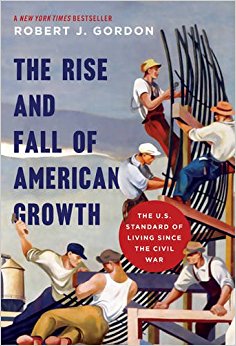
网友对The Rise and Fall of American Growth: The U.S. Standard of Living Since the Civil War的评论
Although written by an academic and published by an academic press, it is quite readable for the layperson, even at 652 pages of content. Gordon did has homework as you would expect and presents an interesting case. Silicon Valley would have you believe that every latest innovation is world changing, although the reality is many are vanity products for affluent younger techies living in urban areas. The premise of the Rise and Fall is that real growth and life-changing innovations really occurred between 1870-1940. It is hard to argue that Twitter, Tumblr and Instagram are more important than clean water, indoor plumbing, indoor heat, the railroad, automobiles and electricity. No doubt these developments along with great advances in medicine such as penicillin are far more important in the long sweep of history. The second premise of the book is that growth has slowed considerably and that it is a permanent condition that we need to get used to, in other words, the productivity that came from the 1870-1940 period is impossible to reproduce and in fact the rapid growth of that period WAS the anomaly. Although Gordon makes a compelling case, I think ultimately it is hard to predict future innovations. Hopefully his thesis is the 21st century equivalent of the famous patent commissioner who said in 1899, "everything that can be invented has been invented." and the future is bright. A thought provoking read.
The author has a wealth of knowledge. Writing a book spanning across almost 150 years of history is no small task. What impressed me most is the author's knowledge on so many different topics. The author has done an excellent job in organizing the materials and makes it easy to read.
Setting aside the reference pages, the book is about 700 pages. If you are unsure whether this is the right book for you, the author did a presentation for LSE which will give you a good indication whether you will like this book or not. You can look it up on google.
You might not agreed with everything in the book. But there is certain truth when it comes to things such as social media. For example, do we consider Facebook a technology company and does it increase productivity? There are a lot of discussion on which technology is a big driver for growth and which one is not. For example, invention such as Penicillin was a small idea that saved millions of lives. But let's not forget the fact that there are other factors such as the two World Wars have shifted power from Europe to the US. And the immigrants from Europe and other countries have been a big part in driving the economic growth of this country.
I also applaud the author for making a bold prediction for the future. Currently, there is so much hype about machine learning and deep learning. And yet, nobody question the usefulness of artificial intelligence. Does it really increase productivity? And at the end of the day, do people care more about productivity or living standard? For a lot of people, if they cannot make a living, why would they care about growth?
If one can read the book with an open mind, you can learn a lot from the book. I certainly benefited from it.
It seems like at least half of the 5 star reviews are fake. How could you otherwise explain a two line review of a book with more than 700 pages?
I do not think this is a book for a larger audience. It contains too much information and is too unfocused. However, it is a very interesting book if you have a special interest in economic history, industry growth and decline, product innovation, and productivity.
The first half of the book contains a lot of data about different industries. This can be very interesting if you have a specific purpose with your reading. Otherwise, there is just a lot of information. This is the most worked through part of the book.
The book has become known for the author's pessimism of the future productivity growth. That is unfortunate, because such a case could have been done in a 30 page essay. I don't agree with this thesis at all. The 1870 to 1940 period will always be the most important because it was almost like going from 0 to 1. Current technologies like solar power, Internet, artificial intelligence, robots, 3D-printing could have a huge impact on society, but it would never be a 0 to 1 development. This is where I think the author end up with a very wrong conclusion. Just one example: He describes the big innovations in retailing (e.g. big box stores, barcode scanners) and claims that there is no innovation in retailing today. Internet might be less revolutionary, but to argue that it is minor is ridiculous. So we might not see 4% growth per capita again, but 2% growth per capita from a higher base is still a larger increase in absolute terms.
In the last chapter, the author starts talking about inequality being a root cause for the current situation. This whole chapter reads like the Democratic party program. This is an example of how unfocused the book is. The author wants to include everything he cares about.
Overall, I still recommend this book. It would have been better as two books, but that is a minor complaint.
喜欢The Rise and Fall of American Growth: The U.S. Standard of Living Since the Civil War请与您的朋友分享,由于版权原因,读书人网不提供图书下载服务